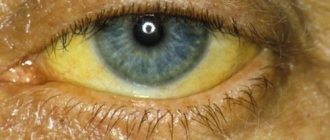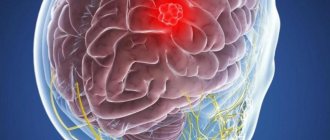Sometimes during stressful situations one can observe inappropriate behavior of a person. Perhaps these are the first symptoms of schizophrenia. But without qualified research and special tests performed by a psychiatrist, it is almost impossible to establish a correct diagnosis.
- Postpartum female schizophrenia
- The first signs of schizophrenia
- Stages of schizophrenia
- About treatment
- Video on the topic
In women, this disease has quite complex symptoms. But even if initial symptoms appear, an urgent consultation with a doctor is necessary. Since it is much easier to carry out treatment at an early stage, before an exacerbation, and at the same time reduce the level of mental disorder of the patient as much as possible. Also in this case, the participation and full support of family and friends is necessary, which is important for women.
Pathology such as schizophrenia is mainly inherited. But not only a hereditary factor can contribute to this disease. The disease can also be triggered by various stressful situations, alcohol abuse, and various psychoactive substances.
Features of inpatient treatment
Hospitalization of a patient with schizophrenia in a hospital is carried out in order to protect the patient from the progression of the disease, and his psyche from further decay.
This is especially true for patients under the influence of delusions and auditory hallucinations, which are dangerous both for themselves and for the people around them. In addition, it is quite important to move the patient away from the place where he developed the attack, strictly speaking, to change the negative environment for him. In the hospital, he will be under 24-hour supervision and will be provided with 24-hour medical care and support.
This forced measure will also help the family and friends of a schizophrenic person prepare for further outpatient treatment of the patient at home after the acute attack of psychosis has subsided.
Schizophrenia refers to chronic diseases that destroy the human psyche. It can occur continuously, or it can manifest itself in attacks, which become more and more pronounced each time. If the disease does not cause obvious signs in the patient, then the person may simply become very dry, he will lose interests, he will stop experiencing emotions and showing any desires. According to the ICD, schizophrenia is coded F20.
The disease is classified according to its manifestations, and the types of schizophrenia in adults and children are partially different. This is due to the fact that certain symptoms are characteristic only of a particular age.
In adults, schizophrenia has the following types:
- Simple - there are practically no external manifestations of the disease, there are no hallucinations, the person behaves naturally, but gradually becomes unemotional, dry in relationships and withdrawn.
- Paranoid (paranoid) - the patient is sure that another person or group of people is reading his thoughts, provoking illnesses and persecuting him, and in some cases he feels fake superpowers.
- Catatonic - a person is distinguished by repetitive movements, he can sway in different directions, walk in circles, continuously wave his arms, repeat the same words over and over again.
- Hebephrenic - the patient’s behavior resembles a child, he often teases others, jokes inappropriately, jumps and makes faces, while he is not aware of the asocial nature of his behavior.
A sluggish form of schizophrenia is also distinguished separately. It is characterized by very slow development, and only the rate of formation of irreversible mental damage is assessed, and the severity and speed of manifestation of symptoms have no significance. Most often it is combined with loss of emotionality and interests, antisocial behavior, as well as impaired speech and intellectual functions.
In most cases, children are diagnosed with a sluggish form of the disease. There have also been many cases of malignant schizophrenia, which has an extremely negative impact on the overall development of the baby. Other types are found much less frequently, which is due to the characteristics of the child’s psyche. A small child or teenager prone to schizophrenia will begin to feel a worsening of the condition over time, and the disease may develop into a new form.
Classification of schizophrenia
Based on clinical symptoms, the DSM-4 distinguishes five types of schizophrenia:
- Paranoid schizophrenia - there are delusions and hallucinations in the absence of emotional flattening, disorganized behavior and thinking disorders
- Disorganized schizophrenia (hebephrenic schizophrenia) - thinking disorders and emotional flattening are identified
- Catatonic schizophrenia – psychomotor disturbances predominate
- Undifferentiated schizophrenia - psychotic symptoms are detected that do not fit into the picture of catatonic, hebephrenic or paranoid schizophrenia
- Residual schizophrenia – mild positive symptoms are observed.
Along with those listed, the ICD-10 identifies two more types of schizophrenia:
- Simple schizophrenia - gradual progression of negative symptoms is detected in the absence of acute psychosis
- Post-schizophrenic depression - occurs after an exacerbation, is characterized by a persistent decrease in mood against the background of mildly expressed residual symptoms of schizophrenia.
Depending on the type of course, domestic psychiatrists traditionally distinguish between paroxysmal-progressive (coat-like), recurrent (periodic), sluggish and continuous schizophrenia. Division into forms taking into account the type of course allows you to more accurately determine the indications for therapy and predict the further development of the disease.
Causes and symptoms
For many schizophrenics, the disease first begins to manifest itself in adolescence, but more often it makes itself felt in men 20-25 years old, as well as women 25-30 years old. Moreover, in the stronger sex it develops much more rapidly. The causes and symptoms of schizophrenia are almost the same for all people.
Causes
The development of schizophrenia can be triggered by a large number of different factors. None of them can be considered a direct cause of the disease, because many people who encountered them remained healthy. However, under certain circumstances they cause schizophrenia. These include:
- Infectious or viral diseases in the mother during pregnancy;
- Genetic predisposition (schizophrenia in parents);
- Psychological trauma, childhood fears, prolonged exposure to severe stress;
- Harsh upbringing, inappropriate behavior or violence from parents;
- The influence of the environment when living in a big city;
- Alcohol abuse or smoking;
- Low social status, loneliness, lack of communication.
Before you can recover from schizophrenia, you will need to identify the cause of its occurrence, because... we will have to fight it too, if possible. This point is especially important when the disease develops in a small child or teenager.
Symptoms
The manifestations of schizophrenia can be very mild, which is why the relatives of some patients do not even suspect that there is a problem. But gradually the symptoms will intensify, causing more and more abnormalities. Therefore, at a certain point the disease becomes noticeable to others. Signs of schizophrenia are divided into three types:
- Positive symptoms. It is impossible to hide them; they are very noticeable to everyone who is near the patient. They manifest themselves in the form of delusions, hallucinations, intense persecution mania, unreasonable fear, repeated repetitions of words or actions, changes in voice, as well as increased physical agitation. Positive symptoms may be present for a long time or occur in attacks during an exacerbation.
- Negative symptoms. They appear in the patient at the very beginning of the development of schizophrenia, and they are much more difficult to notice. Such symptoms include loss of interest in the world around us, decreased emotionality, apathy, and reluctance to communicate with other people. In later stages of the disease, complete withdrawal from social interaction and personal hygiene is also possible.
- Cognitive symptoms. Such manifestations arise gradually, sometimes it is very difficult to notice them, and some doctors may confuse such symptoms with other diseases. The patient risks losing the ability to see logical connections, form personal conclusions, plan work, remember information, organize rest, his thinking will become vague and non-abstract.
Some patients invent their own language or do not react at all to attempts to speak to them by people around them. Symptoms in most cases are individual and may change, because Much depends on the stage of the disease and the characteristics of the person’s psyche.
The cause of the disease is the theory of inheritance of a defective gene that provokes a personality disorder. This theory is confirmed in practice. Approximately 50% of children with parents diagnosed with schizophrenia, starting in infancy, demonstrate persistent symptomatic complexes of the disease.
The main prerequisites for the formation of personality occur during puberty. A poorly developed instinct of motherhood, as well as hormonal disorders, contribute to the development of an imbalance in perception of both the surrounding world and one’s personality. The primary complex that provokes pathological personality changes consists of dissatisfaction with personal appearance.
The causes of schizophrenia in women also include the following factors: disruption of the psychological climate in the family, prolonged stress without a productive outlet; neurotic personality type; postpartum depression; lack of integrity of personal characteristics; the presence of various phobias and complexes.
Up to 2% of all diagnosed diseases contain bacterial or viral etiology. Manifestations of schizophrenia in women in this case occur after bacterial or viral meningitis.
Features of senile schizophrenia
There are several types of schizophrenia. Hebephrenic schizophrenia is characterized by the manifestation of childish behavior and foolishness. Patients prefer to be alone with themselves; they are very shy. The main symptom of paranoid schizophrenia is delusions, auditory and other hallucinations. It is very often observed in old age. Catatonic schizophrenia is characterized by alternating stupor and hyperarousal. Sometimes the disease is diagnosed in early childhood and gradually progresses with age. Schizophrenia can also be acquired in old age. In adolescence, schizophrenia can sometimes be virtually asymptomatic, but after 40 or 60 years of age a sharp deterioration occurs. Sometimes the symptoms of senile schizophrenia can be confused by relatives of an elderly person with senile dementia.
According to statistics, 1% of people over the age of 65 suffer from senile schizophrenia, 25% of whom are diagnosed with the disease at a late age.
Early signs and symptoms of schizophrenia in women
What is schizophrenia, what are the symptoms and signs in women?
Schizophrenia is a mental illness that is characterized by suppression of emotional functions and disruption of the thinking process.
The disease does not respond well to treatment. Symptoms and early signs of schizophrenia in women in behavior depend on the type of disease, influencing factors, neglect, which is reflected in the behavior of schizophrenic women.
The disease affects people regardless of their level of intelligence, otherwise called the “queen of madness.” In this case, the brain adequately perceives information and remembers, but distortion occurs at the processing level.
Causes
The disease appears at different ages, the onset of development occurs at 25-30 years. What are the signs of schizophrenia in young women? Why does schizophrenia occur in women?
Several theories of the development of schizophrenia are known in medicine. Heredity, hormonal disorders, autointoxication, stress, and experiences influence it.
Childbirth can serve as a trigger for the manifestation of the disease. Therefore, in the postpartum period, the first signs of schizophrenia may be observed.
But even if a woman has not given birth, symptoms of schizophrenia may appear as a result of genetic predisposition as a result of heredity. But only in this case will the trigger be another factor.
- dopamine has increased levels in the blood;
- serotonin receptors are activated;
- the noradrenergic system may malfunction;
- disruption of processes in the brain;
- asocialization, conflicts and quarrels with other people;
- the brain lacks oxygen;
- stress, various types of depression, problems in relationships with loved ones.
A constant feeling of fear of being rejected prompts you to avoid communication and contact with other people. There is a term "schizoid temperament". These are people who lack trust in others, they feel like there is a conspiracy around them, or they are actively trying to change the world around them.
Behavior, obvious signs and symptoms of schizophrenia in women, how to recognize schizophrenia in women in their behavior? Statistics report that for every 1000 women, 8 have a mental illness.
Schizophrenia is less common in women than in men. There is a tendency to increase the number of patients, especially in older women.
The disease is characterized by a slow development process. In the functioning of the brain, metabolic and metabolic processes malfunction.
Schizophrenia as a disease is not something new, it just takes on a slightly different look in the modern world. Unfortunately, it is impossible to completely get rid of the disease, but the patient’s behavior and condition can be corrected and, as a result of professional help, a positive result can be achieved.
It is important to recognize the signals, symptoms of female schizophrenia and signs of mild schizophrenia in women in time and undertake treatment. Next, we will look at the first signs of schizophrenia in a girl at the initial stage.
Treatment of schizophrenia with folk remedies
The first signs of schizophrenia in women, how does schizophrenia manifest itself in women in behavior?:
- the patient refuses to carry out her usual activities because they seem pointless to her;
- conversation in monosyllabic sentences, speech difficulties (slowness, disturbances);
- using meaningless rituals (polishing a chair 3 times before sitting down, counting to 10 before entering the house, etc.);
- difficulty concentrating on one thing;
- abandoning activities that previously provided value.
There are also other signs and symptoms of schizophrenia in women. Often women with schizophrenia are so concentrated that they do not see the surprise of the people around them and cannot give an account of their senseless actions. Emotional inadequacy is weakly manifested. But over time, the disease progresses and new symptoms and new attacks of schizophrenia are added.
Schizophrenic women begin to become interested in things that they previously did not pay attention to. As a rule, it is expressed in interest in creativity - drawing. These are unusual, bizarre, sometimes frightening drawings. It is difficult for a healthy person to understand them.
It is important to remember that people with symptoms of schizophrenia do not see the problem and claim that they are completely healthy, so it is difficult to persuade them to undergo examination and treatment. In the first stages, it is better to consult a doctor than to start the disease.
Schizophrenia affects the brain in four ways:
- Alogy is revealed in the difficulty of building a logical chain, the inability to express one’s thoughts and reasoning to the end in an understandable form.
- Autism – the patient keeps his distance from people, thinks in patterns and stereotypes. Prefers to spend time alone, behaves strangely, and loses productivity.
- Inadequacy - the emotions of such a person practically defy any logic. The patient may blame and scold someone for no reason, laugh at a funeral, or cry at a wedding.
- Ambivalence is a manifestation of conflicting feelings towards surrounding people, actions and objects. A person can have brilliant or delusional ideas; a schizophrenic can experience love and hatred at the same time.
How does schizophrenia occur in women?
In communication, these are very difficult people. A woman can come up with new words for familiar things. Old sayings are given new meaning. But even if changes are present in the thinking and emotional sphere, the intellect remains unchanged.
A woman does not forget her skills and knowledge, and can use them if necessary. As a rule, during the day a woman behaves more or less calmly, but in the late afternoon or at night the symptoms worsen.
Experts divide mental illness into two main categories - the positive form and the negative form. Behavior in women with schizophrenia changes, the woman becomes nervous, shows aggressiveness, withdraws into herself, and has an unkempt appearance.
There are several types of pathology, so schizophrenia manifests itself in different ways:
- Sluggish is characterized by minor, paroxysmal symptoms. A woman’s relationships with loved ones are disrupted, and interest in usual activities disappears. Hypochondria gradually develops, a condition in which a woman is constantly looking for various diseases in her body, and can be absolutely healthy. At the same time, a woman can describe health problems in a fantastic way. For example, the feeling of worms migrating throughout the body, blood flowing in different directions.
- Paranoid
The first external signs and unusual behavior are noticed by those close to her and may suggest that a woman needs to pay attention to her mental status, go to a consultation with a psychotherapist or psychologist, but in no case are they a reason for a home diagnosis of a mental illness.
Precursors of schizophrenia in women are non-specific, however, the appearance of the symptoms listed below should not be ignored.
One of the earliest manifestations of schizophrenia, as well as depressive states, is a gradual lack of interest in one’s appearance. Women mainly attach great importance to this factor.
Sometimes a woman begins to dress very bizarrely and completely inappropriate for the occasion. Family members may notice that their daughter or mother has stopped brushing her teeth regularly, showers much less frequently, changes clothes much less often, and the intervals between these actions are lengthening.
At the very least, such symptoms indicate emotional burnout, when habitual and automatic actions become simply impossible.
At the same time, you can notice that the girl, sociable and often on her phone, began to sit at home more and communicate less with her girlfriends and friends, even with family members. At the same time, you can notice that this is not caused by some new hobby or job.
She just sits or lies, clearly not doing anything, preferring loneliness to everything, stops watching her favorite films, reading her favorite books, doing what fascinated her before. She is not attracted to new clothes or previously loved food.
Later, absences from classes may begin if the girl is studying, absenteeism at work, loss of interest in walks, visits to theaters, cinema, exhibitions - everything that previously fascinated her. As the periods of isolation increase, she clearly prefers her own company.
Of course, there are more reserved and more sociable women, however, all of them are capable of simultaneously solving several problems, share their experiences with friends, and are not indifferent to their appearance. They tend to improve and decorate everything. Therefore, the changes in behavior described above become noticeable quite quickly.
Behavior in women with schizophrenia changes as their perception of the world changes.
In addition to withdrawal into oneself and a disdainful attitude towards appearance, noticeable suspicion, an unkind attitude towards others, and sometimes outright causeless hostility attract attention.
They may experience increased drowsiness or insomnia, and noticeable problems concentrating, which negatively affects their studies or professional activities. Although the knowledge and skills acquired before the manifestation of the disease are retained.
Characterized by inappropriate reactions, strange statements, complete intolerance of criticism addressed to oneself, a schizophrenic cannot be convinced by any reasonable arguments and logical conclusions.
Another possible sign of schizophrenia is a sudden strong passion for religion, the occult, esotericism, and superstitions. This is facilitated by an ever-increasing disconnect from reality. Schizophrenic women are more susceptible to supernatural beliefs and over time can become completely immersed in a mystical, unreal world.
Peculiarities
What contributes to the development of the disease (causes)
As mentioned above, signs of schizophrenia in women appear at a young age. The disease is often confused with depression, especially when it appears during the postpartum period. In fact, labor can provoke changes in hormonal levels and disruption of metabolic processes, which leads to the accelerated development of schizophrenia.
In addition, schizophrenia in women appears as a result of:
Not only a doctor, but also family members living with the patient can determine the first signs of schizophrenia in women. The woman withdraws into herself and becomes indifferent to the lives of her loved ones. Character and habits change. The patient herself does not notice any changes in herself. It is very difficult to persuade a schizophrenic to undergo diagnosis and treatment.
Diagnostics, treatment regimen
Treatment for schizophrenia must begin with a diagnosis, which will require a special examination, and the drawing up of a treatment plan. To do all this, you need to come to an appointment with a psychiatrist.
Diagnostics
The examination begins with a survey of a psychiatrist. The doctor will examine the patient, talk to him, and after that he will be able to draw preliminary conclusions. If there is a suspicion of schizophrenia in a child, then parents must be present at the appointment, because They will be required to provide a detailed account of observations of the baby and all manifestations of the disease. The main task at this stage will be to determine the expected diagnosis and find out the possible root causes of the disease.
After this, you will need to undergo special examinations:
- Neurotest. This research method requires donating blood from a finger. With its help, a laboratory specialist will be able to analyze many indicators related to the disease in order to confirm the diagnosis and choose the right treatment.
- NTS (Neurophysiological test system). With the help of this diagnosis, the doctor examines a person’s behavior, as well as his reactions to certain stimuli. It is such observations that make it possible to identify deviations, including schizophrenia.
Additionally, other tests may be prescribed, as well as MRI or EEG, which will help exclude other pathologies. In most cases this is not necessary, because... schizophrenia is obvious.
Treatment regimen
It is believed that it is impossible to cure schizophrenia forever, because... she does not respond to any therapy. Nevertheless, every person has the opportunity to suppress this disease, completely taking control of its manifestations. To do this, you will need to go through all stages of treatment, without neglecting any of the methods. Immediately after diagnosis, the doctor will make a decision on future therapy.
- The first stage of treatment is carried out in a hospital. The only exceptions may be mild cases, which are quite rare. Hospitalization is necessary for the vast majority of patients, because they can be dangerous to themselves and others. Also, during inpatient treatment, there is the possibility of intensive therapy, which involves the active use of medications. As a rule, the duration of the first stage is from 1 to 3 months.
- The second stage of therapy can be carried out at home. Patients with mild and indolent schizophrenia often skip the first stage with hospitalization, proceeding directly to the second. And those who were in the hospital are discharged and begin home treatment. This period can last up to 9 months. The patient will need to take medications, work with a psychotherapist, and follow other doctor’s recommendations. Sometimes patients are prescribed a day hospital, i.e. they need to visit the hospital every day, but they live at home.
- The third stage is softening. At this time, the schizophrenic should take medications in a reduced dosage, and also intensively engage in rehabilitation therapy, following all the doctor’s recommendations. The period can last up to one year. During this time, you will only need to visit the hospital once a month to evaluate the effectiveness of treatment by your doctor.
- The fourth stage is the final one. The main goal for this period is to prevent relapse and the development of any other mental disorders. It can last for a very long time, because... Maintenance of the condition is an important component of treatment. The patient will need to take the pills constantly or at certain intervals, and special attention will have to be paid to the prevention of the disease.
Only after going through all the stages can a schizophrenic person count on the restoration of his psyche and the normalization of his condition. When you manage to get rid of the disease completely, do not forget about the importance of regular visits to the doctor to check the condition.
Stages of schizophrenia
It is good if a person manages to detect the disease at an early stage of schizophrenia. The sooner you can begin to treat the disease, the greater the chances of getting rid of the possible severe consequences of this disease.
In the first stage of schizophrenia, patients experience slight changes in character, behavior and inclinations. The duration of this stage can vary and varies from patient to patient.
The second stage is characterized by the emergence of obsessive ideas. A person can double-check several times whether he has turned off the water and whether he has locked the lock on the door. Depressive states and complaints of a complete lack of thoughts occur periodically.
Consequences if left untreated
Schizophrenia is a severe mental disorder that, without timely and qualified treatment, can lead to the following serious consequences:
- development of dementia;
- death in case of suicide or hypertoxic form of the disease;
- a complete change in the patient’s personality;
- the presence of multiple mental defects;
- complete isolation from society.
Schizophrenia in women after childbirth occurs due to severe stress, both physical and psychological. Since the psyche of a woman giving birth is unstable and often subject to influence. Therefore, childbirth can often provoke mental disorders. However, it should be noted that schizophrenia in women after childbirth is a rare phenomenon and the likelihood of the disease itself is significantly low.
But still, some provoking factors are noted, including hereditary predisposition, loneliness and the resulting depression, postpartum depression, and lack of communication. These factors may influence the occurrence of schizophrenia in women after childbirth.
Hallucinogenic disorders and delusions
One of the leading symptoms of schizophrenia in both men and women is the presence of delusional and obsessive ideas. It is very difficult to guide such patients on the right path and convince them that their actions are wrong.
Schizophrenia is characterized by delusions of physical influence. In this case, we are talking about the patient’s complaints that someone is conducting covert surveillance from a neighboring house or the roof of a high-rise building. Acting on the consciousness of the patient, this someone gives various instructions. The schizophrenic clearly hears the voices of certain creatures in his head and says that he sees bright pictures that the aliens show him. Women often detect a foul odor, although a healthy person does not feel anything like it.
A schizophrenic may imagine himself omnipotent and claim that he can influence the exchange rate of the dollar or help a friend get a high rank.
Complementary therapy
The main ways to best get rid of schizophrenia include medication and psychotherapeutic treatment. They are most effective and can be used for people of any age. But treatment should begin only after receiving a doctor’s prescription.
Taking special medications is a prerequisite for eliminating symptoms. When the patient begins to take medications, he will gradually overcome one symptom after another. After some time, all manifestations of schizophrenia will disappear, and the person will feel good.
Drugs and dosage are always selected individually. They may change during therapy, because It is very important to choose the most effective remedy. It should be borne in mind that the first effect will become noticeable only a few weeks after starting to take the medication.
The prescribed drugs have 3 goals: to relieve symptoms, stabilize brain function, and maintain the patient’s health. Several categories of drugs can be used for this:
- Neuroleptics (Aripiprazole, Olanzapine). They are the basis of treatment and help get rid of delusions, hallucinations, closed personality, and also restore the patient’s mental state. Antipsychotics are administered intravenously or taken in tablet form.
- Tranquilizers and sedatives (Lexotan, Propazine). They calm the patient, help overcome anxiety and fear, relieve persecution mania, and reduce physical arousal. Relatives should control the use of such funds, because a schizophrenic may take too large a dose, which is extremely dangerous.
- Antidepressants (Venlafaxine). The use of such remedies allows one to cope with negative symptoms, relieving the patient of apathy and returning him interest in the world around him. As with sedatives, medications should be monitored to avoid overdose.
Doctors can prescribe other effective remedies, selecting them individually. Additionally, many patients are prescribed modern medications aimed at improving brain function to avoid impairment of cognitive skills, as well as vitamin complexes to maintain general health.
Psychotherapy
The second important component of treatment is psychotherapy. It should be used at any stage of the disease, because The doctor helps you overcome the symptoms and fight schizophrenia on your own. Several psychotherapeutic methods are used, and some of them are aimed at the entire family of the patient. What exactly does the doctor prescribe:
- Behavioral psychotherapy. The goal of the specialist’s work is to bring the patient to awareness and acceptance of his problem, as well as help in regulating the disease and controlling his condition.
- Cognitive activities. Special training of cognitive functions allows you to avoid the loss of many skills and knowledge, as well as restore lost ones. This therapy is especially effective for adolescents.
- Psychoeducation. This technique involves conducting group sessions in which patients must make sure that others have the same problem. Their goal is to alleviate the patient’s condition and restore his psyche.
- Family psychotherapy. The doctor works with all family members at once, explaining the peculiarities of interaction with the patient, while the specialist helps them accept the state of the schizophrenic and learn to bear responsibility.
- Occupational therapy. Gradually, the specialist teaches the patient to perform this or that work, which helps develop his social skills and increase his ability to work. After a few sessions, patients become more independent and will require much less assistance with daily tasks.
If a child suffers from schizophrenia, parents must not only take a responsible approach to the treatment procedure, but also support the patient throughout all stages of therapy. Therefore, family psychotherapy classes are especially important for them.
It is recommended not to limit yourself to medications and psychotherapy and to use additional methods, as well as to treat schizophrenia with folk remedies. They can only be used after consultation with your doctor, because... there is a possibility of developing side effects.
Unusual methods
It is allowed to use other methods of treatment that are not so widely used. They complement the main therapy, enhancing the effect against the disease. Can be used:
- ECT. Electroconvulsive therapy is used in cases where the patient has movement disorders (frequent, repetitive movements that he cannot control).
- Insulin comatose therapy. Prescribed when there is no effect from the main treatment. This therapy involves injecting a small amount of diluted insulin into the blood through a needle. First, the patient falls into a coma, and then returns to a conscious state when he is additionally injected with glucose. This has a positive effect on the mental state of the patient.
- Hypnosis. Conducting several hypnotic sessions helps the patient overcome the symptoms of schizophrenia, because... the openness of his consciousness during the procedure allows him to instill any information.
In some cases, the use of such treatments can cause dangerous consequences. Therefore, they are highly not recommended for small children.
Folk remedies
Traditional medicine recipes can perfectly complement drug therapy. They help get rid of many manifestations of the disease, as well as restore the patient’s condition. The two most effective folk remedies are:
- Medicinal comfrey. The herb should be crushed (1 tsp), add water (1 l), boil for 10 minutes, and then let it brew for about one hour. You need to drink one liter of the decoction every day, dividing this volume into small portions. The course of treatment is 2 weeks. The product is excellent against positive symptoms.
- Digitalis. You need to pour boiling water (300 ml) over the plant (1 tsp) and leave for 12 hours. After infusion, take half a glass every 4 hours. The drink effectively eliminates most symptoms.
You can also use a herbal mixture of lemon balm, thyme and valerian. They have a calming effect and relieve many manifestations of schizophrenia.
How does schizophrenia manifest in women?
This mental disorder is very difficult not to notice, since it has pronounced symptoms that are not found in healthy people: non-acceptance of the baby, refusal to fulfill maternal responsibilities, pathological delirium. After the vivid symptoms subside, the alienation that is felt towards the child remains. Some mothers feel in denial about the very fact of having a child.
Various medications are used to relieve symptoms of the disease. It is very important not to distance yourself from a woman with schizophrenia, but to carefully monitor her condition, communicate with her and take as much care of the baby as possible. However, it should be noted that schizophrenics are capable of being happy and living full lives.
Home treatment
During all stages of therapy and rehabilitation, it is important to follow certain rules. The main ones have a therapeutic effect, which is why they should be used by every patient who is being treated at home. If this is not done, the treatment may be significantly delayed.
The basic rules that have a therapeutic effect include:
- Quality sleep. The patient should get enough sleep every day, and sleep at night. If a person suffers from insomnia, then they should consult a doctor to get suitable sleeping pills. Normalizing sleep is a very important task for every schizophrenic, because... this will help in restoring your psyche and general health.
- Proper nutrition. Many schizophrenics lose a lot of weight because... attacks of illness, combined with constant nervous tension, force one to give up food, which causes weight loss. It will be very difficult to overcome schizophrenia in this state, because... the body does not have enough strength for this. It is important to force yourself to eat regularly, and you need to give preference to the right foods and give up fast food.
- Physical activity. It is recommended to start with short walks in the fresh air and yoga, and then move on to light jogging or other sports. Any workout has a positive effect on health. With the help of sports exercises, you will be able to overcome schizophrenia, restoring your psyche and emotional balance.
This unusual method of treatment using sleep, nutrition and sports brings real results. It is not recommended for anyone to skip it. But treatment alone cannot overcome schizophrenia. It is important to monitor your health by following a few simple recommendations:
- Ventilate the apartment regularly.
- Walk outside every day.
- Avoid any stress.
- Wear clothes only from natural fabrics.
- Eliminate all negativity from life.
- Engage in timely treatment of all pathologies.
- Stick to a strict daily schedule.
This is enough to get rid of the problem forever. However, do not forget that if the recommendations are not followed and the medications are stopped after the symptoms disappear, the risk of relapse will sharply increase. Therefore, you should always think about health after schizophrenia.
What is needed for a stable state?
Is it possible to cure schizophrenia completely? Despite the fact that appropriate therapy during the post-remission period will help a person not to suffer from attacks of psychosis at all, this does not mean a complete cure.
The disease still remains and if you abandon the treatment course, the condition will soon worsen. You also need:
It is clear that this will require some effort, but if you try a little, you will be able to minimize or even eliminate attacks of the disease and extend the remission period.
Thanks to rest, rapid recovery from stress is ensured. Of course, you shouldn’t forget about a proper diet either - make sure that it is varied and contains:
It cannot be said that it is possible to treat schizophrenia without the help of psychiatry. Despite the fact that therapy can be carried out at home, it is necessary to prescribe the right medications and undergo certain physical procedures. Dosages of medications most often depend on individual characteristics, which can be considered by a qualified doctor.








